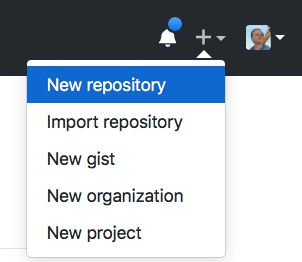Contents - Introduction - Prerequisits - Create the front page repository - Keep the code in the Master branch - Clone your repository
Introduction
All the gh-pages that you publish on github (http://user.github.io) end up in sub-folders named after the repository (e.g. http://user.github.io/”repositiry”). This post explains how to create a front page at http://user.github.io.
Prerequisits
If you just want to build a web page from scratch, all you need is a github.com account. If you want to manage your domain web page from your local machne you also need GitHub Desktop.
Create the front page repository
Log in to your GitHub account and click the plus sign in the upper right corner, from the drop down menu select . You can also to directly to https://github.com/new and you will get to page Create a new repository.

To create the front page for your gitub.io domain account, give your new repository the name , replacing user with your GitHub username (i.e. karttur in my case).
Add a Description and also check Initialise this repository with a README. Then click
Keep the code in the Master branch
When using GitHub for building/deploying html pages normally the special (GitHub self-aware) branch called gh-pages must be used. Not so for the domain front page, here the html (markdown) and associated resources (style sheets, scripts etc) should be associated with the Master branch.
If you want to build a customised front page directly in github.com, you can for instance find instructions at Creating and Hosting a Personal Site on GitHub by Jonathan McGlone. As my pages are built on a customised version of a Jekyll theme, I prefer to clone the repository to a local computer to develop the domain front page on my local machine.
Clone your repository
Clone the repository to you local machine, either using GitHub Desktop or the command-line tool git.

